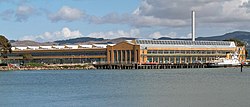Ford Motor Company Assembly Plant
Ford Motor Company Assembly Plant | |
 | |
| Location | Richmond, California |
|---|---|
| Coordinates | 37°54′38.6″N 122°21′30.1″W / 37.910722°N 122.358361°W |
| Built | 1930 |
| Architect | Albert Kahn |
| NRHP reference No. | 88000919 [1] |
| Added to NRHP | June 23, 1988 |
The Ford Richmond Plant, formally the Ford Motor Company Assembly Plant, in
Construction
Built in 1930 during the
World War II
To ensure that America prepared for total war by mobilizing all the industrial might of the United States, President
In mobilizing the wartime production effort to its full potential, Federal military authorities and private industry began to work closely together on a scale never seen before in American history. This laid the groundwork for what became known as the "
Post-war
After the war, the devastation to the local economy as a result of the closing of the Richmond Shipyards would have been crippling had it not been for the continued production of the Ford Plant. The last Ford was assembled in February 1953, with the plant being closed in 1956 and production transferred to the San Jose Assembly Plant because of the inability to accommodate increased productivity demands.
The plant was featured in the movie Tucker: The Man and His Dream. Principal photography started with first unit shooting on April 13, 1987 in the Ford Motor Company Assembly Plant in Richmond, California.
In 1989, the
See also
- National Register of Historic Places listings in Contra Costa County, California
- List of Ford factories
- California during World War II
References
- ^ "National Register Information System". National Register of Historic Places. National Park Service. March 15, 2006.
- ^ a b c "Ford Motor Company Assembly Plant". World War II in the San Francisco Bay Area. National Park Service. Retrieved 2007-04-03.
- ^ a b "Self-Guided Auto Tour" (PDF). Rosie the Riveter/World War II Home Front National Historical Park. National Park Service. Retrieved 2007-04-04.
- ^ Craneway Pavilion: Venue - About
- ^ Skrillex Insomniac Halloween Archived copy
- ^ Björk Breathes New Life Into Craneway Pavilion - East Bay Express
- ^ Rowe, Georgia (30 July 2018). "Why SF Bay Area's West Edge company does opera like no one else". San Jose Mercury News. Bay Area News Group. Retrieved 14 December 2018.
- ^ Lee, Henry; Fernandez, Lisa (April 2, 2020). "The Craneway Pavilion in Richmond used in WWII to be converted into a federal medical station for COVID-19 patients". KTVU. Oakland, California. Retrieved April 2, 2020.
![]() This article incorporates public domain material from websites or documents of the National Park Service.
This article incorporates public domain material from websites or documents of the National Park Service.



